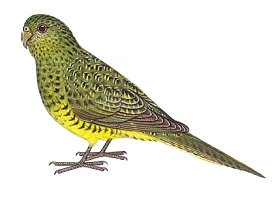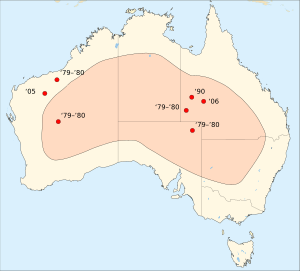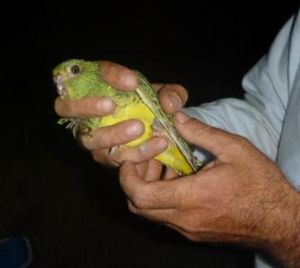Night parrot facts for kids
Quick facts for kids Night parrot |
|
|---|---|
 |
|
| Conservation status | |
| Scientific classification | |
| Genus: |
Pezoporus
|
| Species: |
occidentalis
|
 |
|
| Historical (light red) and recent sightings with year (red dots) | |
| Synonyms | |
|
Geopsittacus occidentalis |
|
The night parrot (Pezoporus occidentalis) is a small parrot that lives only in Australia. It's also known by other names like the porcupine parrot or spinifex parrot. This bird is one of the most mysterious and hard-to-find birds in the world.
For a long time, from 1912 to 1979, no one officially saw a night parrot. People even thought it might be extinct, meaning it had died out completely. Since 1979, there have been a few rare sightings. Because it's so hard to find, scientists believe there are only about 50 to 249 adult night parrots left. This makes it an endangered species, which means it's at high risk of disappearing forever.
Some sightings have happened in places like the Pilbara region of Western Australia, south-western Queensland, and parts of South Australia and the Northern Territory. However, some evidence from a wildlife photographer named John Young was later questioned. In 2019, the Australian Wildlife Conservancy (AWC) removed some of the records that Young had provided.
Contents
About the Night Parrot
How Scientists Name and Group the Night Parrot
The night parrot was first described in 1861 by a bird expert named John Gould. He studied a specimen (a collected bird) from Western Australia. Its scientific name, occidentalis, means "western" in Latin.
At first, Gould thought the night parrot belonged to its own special group, Geopsittacus. But soon, scientists decided it was more like the ground parrot and placed it in the group Pezoporus. This was because its body and feathers were very similar to the ground parrot.
Later, in 1994, scientists used DNA to study the night parrot. They confirmed that it is indeed closely related to the ground parrot. They also found that the kakapo, another parrot Gould thought was related, was actually quite different. In 2011, more DNA studies showed that the night parrot likely separated from its ground parrot relatives about 3.3 million years ago.
What the Night Parrot Looks Like
The night parrot is a small bird with a short tail. Its feathers are mostly a yellowish-green color, with patterns of dark brown, black, and yellow spots. Both male and female night parrots look the same.
You can tell it apart from the two similar ground parrot species because it has a shorter tail. It also lives in different areas and habitats. The night parrot mostly stays on the ground. It only flies when it's scared or looking for water. It's a very shy bird and is active at night. Even when there were more of them, they were hard to spot.
Its home is usually in the dry, dusty parts of Australia, especially where spinifex grass grows. Early reports also said it never went far from water. It might also live in areas with other types of shrubs and eucalyptus trees.
One of the sounds the night parrot makes is a croak, which is thought to be a call to other parrots. Other calls include short "ding-ding" whistles and a longer whistle. These calls have been recorded in Queensland and Western Australia.
What the Night Parrot Eats

Old records show that the night parrot eats the seeds of grasses, especially Triodia grass, and other small plants.
Protecting the Night Parrot
Conservation Status of the Night Parrot
We don't know exactly how many night parrots there are, but their numbers are believed to be still going down. As of August 2020, the IUCN Red List lists the night parrot as Endangered. Before this, it was listed as Critically Endangered, which is an even higher risk. The IUCN Red List estimates there are between 50 and 249 night parrots, or possibly more. The Australian government also lists it as Endangered under its Environment Protection and Biodiversity Conservation Act 1999.
Important Areas for Night Parrots
BirdLife International has identified special places that are important for protecting the night parrot. These include the Diamantina and Astrebla Grasslands in western Queensland. The Fortescue Marshes in the Pilbara region are also very important.
Searching for the Night Parrot
The night parrot is still one of the most mysterious birds for scientists who study birds. It's been very difficult to find reliable records of the bird. After an official sighting in 1912, efforts to find the species again were unsuccessful for many years.
In 1979, a bird expert named Shane A. Parker from the South Australian Museum thought he saw a group of these birds in northern South Australia. Then, in 1990, scientists found a night parrot that had been hit by a car in a remote part of Queensland.
Recent Sightings of the Night Parrot
April 2005: Minga Well Sighting
In April 2005, three night parrots were seen near Minga Well in the Pilbara region of Western Australia. This was close to the Fortescue Marshes.
A large mining project, the Cloud Break mine, was approved in this area. Some people were worried because there were endangered species, like the night parrot, living there. To get approval, the mine had to promise to protect these species. The sighting of the night parrot at Minga Well on April 12, 2005, happened during a survey for the mining company. Two biologists, Robert Davis and Brendan Metcalf, saw the small group of birds. There had been other unconfirmed sightings nearby in 2004.
Davis and Metcalf saw the birds at dusk and couldn't take a photo. However, they were sure they saw three night parrots. Their detailed descriptions were accepted by the Birds Australia Rarities Committee (BARC). This made it the first officially accepted night parrot sighting in modern times. A paper about their sighting was published in a bird journal called Emu in 2008. The biologists searched for the birds again for five nights but didn't see them. A later survey in May 2005 also didn't find clear evidence of the species.
September 2006: A Dead Bird Found
In September 2006, a dead female night parrot was found. It had flown into a barbed wire fence in Diamantina National Park in south-western Queensland.
April 2015: A Live Bird Captured
On April 4, 2015, bird expert Steve Murphy and his partner Rachel Barr caught a live night parrot in southwestern Queensland. They put a radio tag on it and nicknamed it "Pedro." Photos of the bird in Murphy's hand were shared with Australian news on August 10, 2015. The exact location was kept secret to protect the bird. A special conservation area of about 56,000 hectares was created there to help protect the species.
Sean Dooley, from Birdlife: The Magazine, said finding the bird was like "finding Elvis flipping burgers in an outback roadhouse." Philippa Horton, a museum manager, called it "one of the holy grails, one of the world's rarest species probably."
Sightings from 2016 to 2020
- 2016: Nicholas Leseberg, a student from the University of Queensland, took a photo of a young night parrot (a fledgling) in the Pullen Pullen Reserve in Western Queensland.
- January 2017: A whistle call believed to be from a night parrot was recorded in the southern Northern Territory by zoologist Chris Watson and his colleague Mark Carter.
- March 2017: Four birdwatchers from Broome saw and photographed a living night parrot in Western Australia.
- February 2018: Nicholas Leseberg recorded an image of a young bird, about 3 to 5 months old, in Pullen Pullen Reserve.
- June 2017 – April 2018: A special survey confirmed that night parrots were present around Lake Disappointment in Western Australia.
- November 2018: The second known photo of a night parrot was taken in the Great Sandy Desert in the Kimberley region of Western Australia by Indigenous rangers called the Indigenous Desert Lions.
- August 2020: Indigenous rangers from the Martu people and the University of Queensland recorded night parrot sounds in the Pilbara desert, near salt lakes. This was the fifth confirmed location in Western Australia.
Records That Were Questioned
- In May 2013, a naturalist named John Young said he had taken the first ever photos and video of a living night parrot. Young said he had spent 15 years searching for the bird. He showed his findings at a special event but kept the exact location secret to protect the species. Young also provided five feathers from a roosting spot to a museum. DNA tests on these feathers showed they came from night parrots.
- In 2016, Young announced he had found night parrots in Diamantina National Park, next to the Pullen Pullen nature reserve. He reported seven sightings, including a pair of birds and three active nests with eggs.
- In September 2016, a camera trap on land owned by the AWC, Kalamurina Station in South Australia, recorded what looked like a night parrot. However, the photo wasn't very clear.
- In July 2017, John Young and Keith Bellchambers from the Australian Wildlife Conservancy found a single night parrot feather in a finch nest on the Kalamurina property.
- In September 2018, a recording of a night parrot call was downloaded from a sound monitor at Kalamurina.
In October 2018, the Australian Wildlife Conservancy (AWC) started looking into claims that some of John Young's first photos of the night parrot might have been set up. This happened after a bird expert, Penelope Olsen, raised concerns. Young resigned from the AWC in September 2018, and the AWC removed all information about the night parrot from its website.
In March 2019, it was found that Young's reports had problems. A group of experts looked at the nest and eggs found at Diamantina (2016), the feather found at Kalamurina (2017), and the recording of the call (2018). They found that each piece of evidence had issues and could not strongly prove the parrot's presence. Because of this, the AWC removed its reports that were based on Young's work. This shows how important it is for scientific evidence to be very clear and reliable.
Images for kids
See also
 In Spanish: Perico nocturno para niños
In Spanish: Perico nocturno para niños





